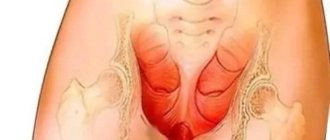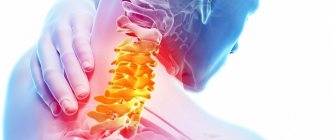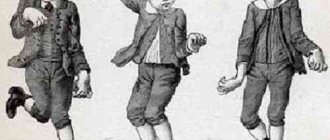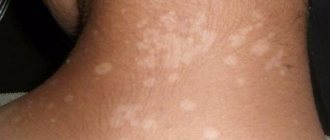HYPOTROPHY
(Greek hypo- + trophe food, nutrition) is one of the forms of chronic nutritional disorder in children, characterized by exhaustion of varying severity. G. occurs mainly in young children.
The causes of G. are very different; they can be of exogenous (insufficient introduction of nutrients necessary for the growth and development of the child) and endogenous (insufficient use of nutrients by the body) origin.
G. can also occur in the fetus during intrauterine development due to various diseases of the mother. At the same time, the subcutaneous fat layer of the newborn clearly does not correspond to its intrauterine age (intrauterine G.).
In infancy, the causes of partial starvation of a child may be hypogalactia and galactorrhea in the mother (see Lactation), incorrect breastfeeding technique, and prolonged feeding with formula that is not appropriate for the child’s age. In these cases, children do not receive the required amount of all or individual food ingredients and calories. Qualitative inferiority in feeding children occurs when carbohydrate or protein foods are overprescribed.
An eating disorder may be associated with a child's illness. With pylorospasm (see) and pyloric stenosis (see), excessive regurgitation and vomiting lead to the fact that the child finds himself in conditions of underfeeding.
In case of some digestive and metabolic disorders, as well as chronic diseases (toxoplasmosis, cytomegaly, congenital syphilis and other long-term diseases), the food taken by the child is not absorbed due to a decrease in the activity of enzymes of the gastrointestinal tract. tract.
Hereditary diseases also lead to significant nutritional disorders in children - cystic fibrosis (see), celiac disease (see) and other enzymopathies (see).
G. can also develop as a result of an incorrect lifestyle and defects in education: insufficient exposure of the child to the fresh air, lack of movement, improper organization of wakefulness, sleep and eating, and especially the lack of positive mental irritations and impressions, contact between an adult and a child. The child becomes lethargic, his normal reaction to environmental influences is reduced, his appetite is disrupted, he eats sluggishly and little and, therefore, finds himself in conditions of malnutrition.
The degree of G. in a child can be influenced to a certain extent by his individual constitutional characteristics.
In children of preschool and school age, G. is, as a rule, a consequence of chronic, intoxication and infectious diseases.
Main causes of pathology
Let's look at this in more detail. Muscular dystrophy has been encountered in our country for quite some time. According to doctors, the causes of muscle wasting can be different, but among the most common are the following:
- Poor quality maternal nutrition during pregnancy and breastfeeding.
- Consequences of various diseases suffered by a woman.
- Abuse of tobacco products and alcoholic beverages.
- Constantly being in stressful situations.
- Unhealthy working conditions.
- Dystrophy in the mother.
- Intrauterine pathologies of infectious etiology.
- Chemical poisoning.
- Intoxication caused by impaired blood circulation in muscle tissue.
- Metabolic disorder.
- Hereditary dystrophic diseases of the muscular system.
- Consequences of long-term use of glucocorticoids.
Thus, the loss of muscle mass in a child largely depends on the mother. If she leads an unhealthy lifestyle and eats poorly, then this will all affect the development of the fetus and the health of the baby. Therefore, women preparing to become mothers should closely monitor themselves.
Symptoms
Signs and symptoms of intrauterine hypotrophy in a child:
- body weight below normal by 15% or more (see below table of the relationship between weight and height of the child)
- height is 2-4 cm less
- the child is lethargic, muscle tone is reduced
- innate reflexes are weak
- thermoregulation is impaired - the child freezes or overheats faster and stronger than normal
- subsequently the original weight is slowly restored
- umbilical wound does not heal well
Acquired malnutrition is characterized by common features in the form of clinical syndromes.
- Lack of nutrition: the child is thin, but the body proportions are not impaired.
- Trophic disorders (malnutrition of body tissues): the subcutaneous fat layer is thinned (first on the abdomen, then on the limbs, in severe cases and on the face), the mass is insufficient, the body proportions are disturbed, the skin is dry, elasticity is reduced.
- Changes in the functioning of the nervous system: depressed mood, decreased muscle tone, weakened reflexes, psychomotor development is delayed, and in severe cases, acquired skills even disappear.
- Decreased perception of food: appetite worsens to the point of its complete absence, frequent regurgitation, vomiting, stool disorders appear, the secretion of digestive enzymes is inhibited.
- Decreased immunity: the child begins to get sick often, chronic infectious and inflammatory diseases develop, possibly toxic and bacterial damage to the blood, the body suffers from general dysbiosis.
Clinical manifestations
What should you pay attention to first? Muscle wasting, like any other disease, has certain symptoms, based on which the pathological condition can be detected. Among the most characteristic manifestations are:
- general weakness in the body;
- regular muscle pain;
- inability to perform even simple movements;
- severe decrease in muscle mass;
- formation of the hypodermis in the peritoneum and sternum;
- severe exhaustion of the body.
If these symptoms occur, you should go to the hospital, since muscle dystrophy is similar in its manifestations to some other serious diseases.
Kinds
The disorder can be sudden and complete, like starvation, or gradual. Severity ranges from subclinical deficiencies to obvious debilitation accompanied by edema, hair loss, and skin atrophy.
There are several forms of protein energy malnutrition that can affect a child or infant. The form depends on the balance of protein and non-protein energy sources.
- Kwashiorkor syndrome is a type of severe dystrophy due to protein deficiency. A child suffering from kwashiorkor experiences swelling of the face, legs, thighs and arms, growth failure, muscle wasting, and mental changes occur. Other symptoms include fatty and enlarged liver, moon face, loss of appetite, diarrhea and vomiting. Characteristic changes occur in hair and skin. Develops during breastfeeding and older ages. The development of the syndrome is associated with a violation of cellular immunity, which increases the child’s susceptibility to infectious diseases. Infections release cytokines that worsen muscle wasting, cause anorexia, and lower serum albumin levels.
- Nutritional insanity. This is a form of protein malnutrition that causes severe muscle wasting, fat loss, leading to large weight loss, cessation of mental activity and complete exhaustion.
- Cachexia. A condition caused by loss of protein, resulting in weakening of skeletal muscles. Often associated with chronic diseases such as AIDS, cancer, chronic renal failure, chronic obstructive pulmonary disease and rheumatoid arthritis. Decreased protein intake occurs in patients suffering from colon, stomach, liver, pancreas and biliary tract cancers. Reducing calories and micronutrients leads to fatigue and negative nitrogen balance.
- Marasmic kwashiorkor - In this form, patients have a combination of signs and symptoms of both kwashiorkor and marasmus.
- Low protein intake in infancy and preschool age. Children suffering from this form of protein-energy malnutrition are below normal weight and height. They are at greater risk of stomach and respiratory infections and have poor health. This is due to poor nutrition of the mother and child, frequent infections and diseases. Children with stunted growth and weight cannot fully achieve mental and physical development appropriate for their age.
Protein deficiency can also occur in older people, especially those living in nursing homes, with an estimated 20 percent of them experiencing malnutrition.
Classification
Muscle wasting is divided into different types depending on a number of factors. According to the time of manifestation, the disease is divided into:
- congenital;
- acquired.
Depending on the degree of muscle damage, the pathology is:
- generalized;
- localized.
The first is extremely rare in medical practice. When it occurs, muscle tissue throughout the body is damaged. Localized, in turn, is the most common. Hypotrophy of the muscles of the lower extremities can manifest itself in the thigh or lower leg area. With dystrophy of the upper extremities, the damage can spread to the hand, forearm and shoulder. The different degrees of the disease will be discussed in more detail in the following sections.
Symptoms
Symptoms of malnutrition: 1 - healthy child;
2 — malnutrition of the 1st degree; 3—grade 2 malnutrition; 4 - grade 3 malnutrition The clinical picture of fetal malnutrition manifests itself in the form of disruption of several systems at once. First of all, symptoms appear in the gastrointestinal tract:
- bloating;
- refusal to eat, poor appetite;
- nausea and vomiting;
- sudden weight loss.
As the disease develops, the clinical picture is supplemented by the following symptoms:
- poor sleep;
- impaired coordination of movements;
- decreased muscle tone;
- sudden mood swings in the child;
- emotional unstable background.
Also, against the background of such a clinical picture, the protective functions of the body sharply decrease in young children. Therefore, a child under one year old becomes easily vulnerable to any infections and viral pathological processes.
Hypotrophy of the upper limbs
In the vast majority of cases, it develops as a result of poor blood circulation in the hands or insufficient supply of muscle tissue with nutrients. At the same time, motor function in the upper extremities is preserved, however, the performance of movements and basic tasks becomes significantly more complicated. The following reasons may be behind this dangerous disease:
- regular excessive physical strain;
- various rheumatoid diseases;
- diabetes;
- dysfunction of the thyroid gland;
- excessive obesity;
- autoimmune disorders;
- consequences of previous injuries;
- congenital physiological abnormalities.
This type of disease is characterized by slow, sluggish development. Regardless of the degree of damage to the muscle fibers, a person retains sensitivity and partial mobility of the hands.
Etiology
The causes of malnutrition can be divided into two groups:
- exogenous (associated with external factors);
- endogenous (internal causes).
| Causes of malnutrition | |
| Exogenous | Endogenous |
| 1. Nutritional factors (related to nutrition): quantitative deficiency and / or qualitative imbalance of the daily menu, violations in feeding methodology (long breaks between meals, erratic eating, improper attachment to the breast, aerophagia, etc.). 2. Social factors: pallor, unconventional ideas about age-related nutrition or insufficient food culture of the family, deviant (antisocial) behavior of parents, care disorders. 3. Infectious factor: acute and chronic diseases: severe respiratory infection (adenoviral, influenza, respiratory syncytial, etc.), a group of intestinal infections, pneumonia, acute pyelonephritis, sepsis, HIV infection, etc. 4. Toxic factor: acute and chronic poisoning with household chemicals | 1. Congenital pathology of internal organs: anatomical anomalies of the gastrointestinal tract: “cleft palate” and severe variants of “cleft lip”, anomalies of the esophagus, pyloric stenosis, Hirschsprung’s disease, etc. 2. Pathologies of the central nervous system: trauma at birth, cerebral palsy, hydrocephalus, congenital neuromuscular diseases. 3. Pathologies of the lungs and heart, accompanied by chronic respiratory or heart failure. 4. Malabsorption of food components: fermentopathy (celiac disease, hereditary forms of disaccharidase deficiency), cystic fibrosis, etc. 5. Endocrine diseases: hyperparathyroidism, diabetes mellitus, adrenogenital syndrome (hereditary pathology of the adrenal glands), etc. 6. Metabolic defects: disorders of amino acid metabolism, storage diseases (a group of metabolic diseases characterized by excessive accumulation of metabolic products in the body), etc. 7. Severe forms of psychosocial deprivation: autism, early onset of mental illness. |
Hypotrophy of the lower extremities
So what do you need to know about this? As mentioned earlier, this type of pathology is one of the most frequently diagnosed. In most cases, patients have hypotrophy of the thigh muscles. Depending on the severity of the lesion, the disease is divided into 3 degrees, each of which is characterized by different symptoms. Among the main clinical manifestations, experts identify the following:
- constant pain of varying intensity in the lower extremities;
- physical weakness;
- problems with walking;
- decrease in muscle mass.
If muscle wasting is diagnosed in time and treatment is started in its early stages of development, then the disease can be completely cured without any health consequences, so the person can return to their usual lifestyle.
Signs
There are several stages of muscle wasting:
- The amount of subcutaneous tissue throughout the body decreases. A person loses up to 20% of body weight. He has pallor, weak appetite, muscle tone decreases;
- Subcutaneous tissue on the abdomen and chest practically disappears. The skin becomes gray, the muscles become flabby, and the liver increases in size. Mental health disorders and irritability occur;
- Severe wasting (cachexia) occurs when the patient loses 30% of muscle mass. The condition requires intensive therapy.
Common symptoms of muscle wasting include the following:
- Constant muscle pain;
- Weakness;
- Inability to perform normal movements;
- Significant loss of body weight.
If areas of muscle wasting are located symmetrically, this raises suspicion of myopathy or spinal amyotrophy. With progressive muscular dystrophy, relatively isolated wasting of the quadriceps femoris or biceps brachii is observed. If malnutrition is located in the distal limbs, we are talking about polyneuropathy (with impaired sensitivity and loss of reflexes in the distal limbs) or Steinert’s myotonic dystrophy.
Unilateral acquired isolated muscle wasting is always a consequence of damage to the root, plexus or peripheral nerve. Decisive for the topical diagnosis is the characteristic distribution of the process of malnutrition and sensory disturbances or prolonged inactivity of the muscle. Hypotrophy of the quadriceps muscle occurs with arthrosis of the knee joint and with sarcoma of the hip. Focal wasting of individual muscles or muscle groups, isolated and sometimes symmetrical, can slowly progress over many years. This is a sign of focal damage to the ganglion cells of the anterior horns or ischemia in the area of the blood supply of the artery.
Hypotrophy of the calf muscles often occurs. With progressive muscular dystrophy, sometimes in significantly hypotrophied muscles areas with intact muscle fibers are identified, which look like nodules. Doctors at the Yusupov Hospital distinguish them from a muscle roll, which is formed when the short head of the biceps brachii muscle is ruptured and is noticeable on the flexor surface of the shoulder.
Diagnosis of the disease
To select the most optimal treatment program, a qualified specialist first needs to identify the problem. To diagnose malnutrition, the following laboratory research methods are used:
- oral questioning of the patient;
- general blood analysis;
- electromyography;
- nerve and muscle biopsy.
If a person simultaneously has any diseases of various origins that occur in a chronic form, then the doctor can refer him for a consultation with other qualified specialists and prescribe additional tests that will allow him to obtain the most complete clinical picture.
Prevention
Prevention has always been and remains preferable and more economical than treatment. Prevention of malnutrition in children consists of adequate breastfeeding, timely introduction of supplementary feeding and complementary feeding, and proper care of the baby.
Oddly enough, but prevention must begin from the childhood of future parents. A balanced diet, physical education and sports, work and rest schedule, sleep, avoiding stress, giving up bad habits, timely sanitation of foci of infection, personal and intimate hygiene, planned pregnancy and carrying it out under the supervision of a specialist in compliance with all recommendations is an effective prevention of complications and guarantee of the birth of a healthy child.
Basic therapy methods
Treatment of muscle wasting is aimed at eliminating the cause of its development, so an integrated approach is very important. Doctors devote their main efforts to reducing the intensity of symptoms and influencing the mechanisms of development of the dystrophic process. At the same time, it is very important to normalize blood circulation so that the affected muscle fibers begin to receive a sufficient amount of nutrients. The therapy program may include the following activities:
- taking medications;
- physiotherapeutic procedures;
- physiotherapy;
- massage;
- UHF therapy.
In addition, the patient should reconsider his daily lifestyle. Particular attention should be paid to the quality of food. The daily diet must be balanced so that the body receives as many vitamins and microelements as possible.
Prevention
Prevention has always been and remains preferable and more economical than treatment. Prevention of malnutrition in children consists of adequate breastfeeding, timely introduction of supplementary feeding and complementary feeding, and proper care of the baby.
Oddly enough, but prevention must begin from the childhood of future parents. A balanced diet, physical education and sports, work and rest schedule, sleep, avoiding stress, giving up bad habits, timely sanitation of foci of infection, personal and intimate hygiene, planned pregnancy and carrying it out under the supervision of a specialist in compliance with all recommendations is an effective prevention of complications and guarantee of the birth of a healthy child.
Drug therapy
To treat malnutrition, drugs are used to improve blood flow in peripheral vessels. Among the most effective are the following:
- "Trental";
- "Courantil";
- "Petroxifylline";
- "Vazaprostan";
- "Dextran".
Also very often, doctors prescribe No-shpu to patients. It not only helps to dilate blood vessels, but also improves the supply of soft and muscle tissues with nutrients. The normalization of metabolic processes is well facilitated by the Curantil tablets. This is a new generation drug with a unique formula; thanks to the bark, high efficiency is achieved in the treatment of many diseases.
Treatment
Neurologists at the Yusupov Hospital prescribe complex treatment to patients suffering from muscle dystrophy, aimed at eliminating the cause of the disease, influencing the mechanisms of development of the pathological process, and reducing the manifestations of the disease. To improve blood flow in peripheral vessels, angioprotectors (trental, pentoxifylline, chimes), low molecular weight dextran, and prostaglandin E preparations (vasaprostan) are used. After dilating blood vessels with no-shpa and papaverine, the supply of muscle fibers with oxygen and nutrients improves.
B vitamins (thiamine hydrochloride, pyridoxine hydrotartrate, cyanocobalamin) normalize metabolic processes and the conduction of nerve impulses. Biological stimulants stimulate the regeneration of muscle fibers and restore muscle volume: aloe, actovegin, plasmol. To restore muscle conduction, prozerin, galantamine, and armin are used.
The drug "Curantil"
Currently, many medications used to treat muscle pathologies can be found on the market. But one of the best, according to specialized experts, is “Curantil”. The price of the drug is higher than that of some analogues, however, it shows better results. The product is available in the form of tablets with different dosages of the active substance. The drug improves blood circulation, increases the strength of vessel walls and reduces the likelihood of blood clots. "Curantil" for the following diseases:
- cardiac ischemia;
- thrombosis;
- cardiovascular failure;
- arterial hypertension;
- atherosclerosis of coronary vessels;
- deterioration of placental circulation;
- oxygen starvation of the fetus;
- endarteritis.
As for contraindications, Curantil tablets are not recommended for use by people who have the following problems:
- cerebral or myocardial infarction;
- angina pectoris occurring in acute form;
- renal or liver failure;
- hypertonic disease;
- dysfunction of the autonomic nervous system;
- cardiac arrhythmia;
- aortic stenosis;
- coronary sclerosis;
- individual intolerance to any of the components of the drug.
Side effects of the drug include nausea and vomiting, as well as stomach upset. However, they are extremely rare, and in most cases the therapy goes well. The dosage and duration of administration are selected by the doctor for each patient individually, depending on the clinical picture and the form of malnutrition. As for the price of "Curantil", it varies from 450 to 830 rubles.
Possible consequences and complications
The following factors complicate the course of malnutrition:
- lack of proper child care in asocial families;
- infectious complications;
- concomitant pathology.
Against the background of grade I and II malnutrition, children often develop intercurrent diseases (pyelonephritis, pneumonia, otitis media).
With III degree of malnutrition, a pronounced developmental delay is observed. The child's general condition is serious.
With stage III malnutrition, complications occur with high frequency. These include:
- Iron-deficiency anemia;
- rickets;
- congestive pneumonia;
- atelectasis in the lungs;
- alopecia (baldness);
- glossitis;
- candidal stomatitis;
- hypoglycemia;
- hypothermia.
Physiotherapeutic procedures
What are they? To increase the effectiveness of treatment, medications are combined with physical therapy. Most often, patients are prescribed the following procedures:
- electromagnetic therapy;
- laser therapy;
- biostimulation;
- iontophoresis;
- therapeutic exercises for injured limbs;
- low-intensity magnetic therapy.
As medical statistics show, if treatment for muscle dystrophy was started in the early stages of its course, then with the help of medications and physiotherapeutic procedures, a positive effect is observed approximately a month and a half after the start of therapy.
UHF therapy
With malnutrition, good results can be achieved by exposing the affected muscles to low-frequency electrical impulses. UHF therapy involves the use of the following treatment methods:
- magnetic therapy;
- electrostatic massage;
- pneumomassage;
- electrical stimulation;
- magnetic stimulation;
- heat therapy.
The procedures listed above help improve blood flow to muscle tissue and normalize metabolic processes, due to which the affected areas begin to receive more nutrients and gradually recover and regain their previous tone. In addition, the patient should regularly perform special physical exercises to increase the effectiveness of physiotherapeutic procedures.
For PEM II degree
dietary correction is conventionally divided into three periods: the adaptation period (determining food tolerance), the reparation period (intermediate) and the period of enhanced nutrition.
During the adaptation period, which lasts 2-5 days, nutrition is calculated based on actual body weight in accordance with the child’s physiological needs for basic nutrients and energy. The number of feedings is increased by 1-2 per day with a corresponding reduction in the volume of each feeding; additional fluid is administered (5% glucose or saline solutions for oral rehydration). During this period, it is preferable to use human milk; in case of its deficiency or absence, adapted infant formula enriched with probiotics, oligosaccharides and nucleotides. It is possible to use formulas with a higher protein content, for example, specialized milk formulas for premature babies. If violations of the breakdown/absorption of food ingredients are detected, it is advisable to use medicinal products (for example, low-lactose mixtures for lactase deficiency, mixtures with an increased quota of medium-chain triglycerides for fat malabsorption). If there is no effect, mixtures based on highly hydrolyzed milk protein should be prescribed. With normal tolerance to the prescribed nutrition, the volume of feedings is gradually (over 5-7 days) increased to the physiological norm. With sufficient rates of body weight gain and the absence of dyspeptic symptoms, nutritional calculations can be made based on the proper body weight, first the carbohydrate and protein components, and only lastly the fat component of the diet.
During the reparation period, it is possible to introduce complementary foods, starting with industrially produced cereals, followed by the introduction of meat, cottage cheese, and yolk. During this period, it is recommended to prescribe enzyme preparations, multivitamin complexes and agents that have a positive effect on metabolic processes.
Throughout the treatment of children with PEM, systematic recording of actual nutrition is necessary with calculation of the chemical composition of the daily diet based on the main food nutrients.
A few words about food quality
The main reason for the development of muscular dystrophy is metabolic disorders, as well as a deficiency of vitamins and minerals in the body. Therefore, the patient must adhere to a special diet aimed at replenishing the supply of nutrients.
The diet must contain foods that contain large amounts of vitamins A, B and D. To increase muscle tone, you should take protein shakes. You should also eat as many fresh vegetables as possible. Bell peppers, broccoli, cauliflower, cucumbers and carrots are considered especially healthy. For animal products, natural cottage cheese and unpasteurized milk are recommended.
What does a baby who is developing normally look like?
Signs of normotrophic:
- Healthy looking
- The skin is pink, velvety, elastic
- Lively look, active, exploring the world around him with interest
- Regular increase in weight and height
- Timely mental development
- Proper functioning of organs and systems
- High resistance to adverse environmental factors, including infectious ones
- Rarely cries
In medicine, this concept is used only in children under 2 years of age. According to WHO, malnutrition is not widespread:
- in developed countries its percentage is less than 10,
- and in developing countries – more than 20.
According to scientific research, this deficiency condition occurs approximately equally in both boys and girls. Severe cases of malnutrition are observed in 10-12 percent of cases, and in a fifth of children it is accompanied by rickets, and in a tenth by anemia. Half of the children with this pathology are born during the cold season.










